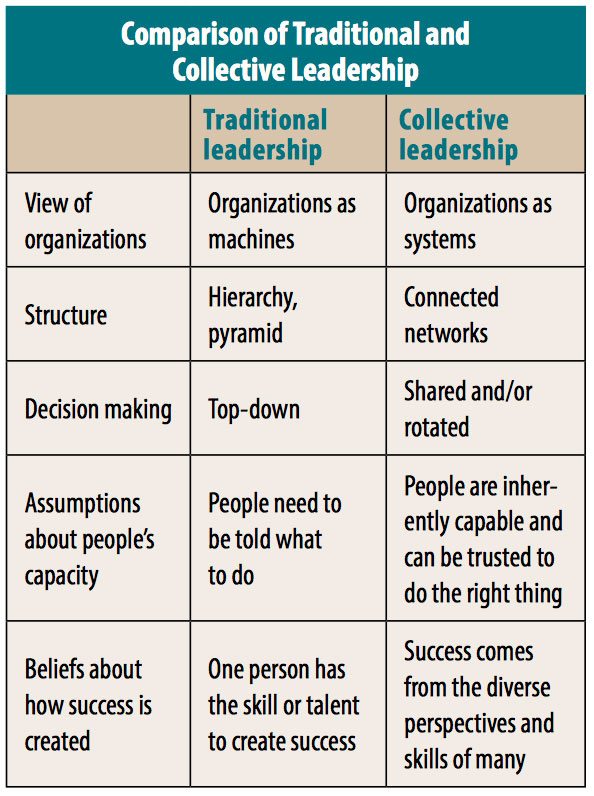
Editors’ note: This article is from the Nonprofit Quarterly’s winter 2017 edition, “Advancing Critical Conversations: How to Get There from Here.” It was excerpted from Five Elements of Collective Leadership for Early Childhood Professionals (Redleaf Press, a division of Think Small, November 2017; Copyright © 2017 by Cassandra O’Neill and Monica Brinkerhoff), with permission. The excerpt has been lightly adapted.
What is collective leadership? How does it compare to a more traditional concept of leadership? Why would anyone want to use it? What are the benefits? How did it develop and what are its theoretical foundations? In this article, we outline key aspects and benefits of the process.
What Collective Leadership Is and Isn’t
We have defined collective leadership as a group of people working together toward a shared goal.1 When collective leadership is happening, people are internally and externally motivated—working together toward a shared vision within a group and using their unique talents and skills to contribute to the success. In fact, collective leadership recognizes that lasting success is not possible without diverse perspectives and contributions.
Collective leadership is a process. It is dependent on the relationships among the parts in the system, whether that system is two people working together; a classroom, team, board, or organization; or a system initiative. In collective leadership, the way the group works together makes it different from a more traditional model of leadership. How the group works together and the unique results that are possible only when this happens differentiate a group that is sharing leadership from one that is not.
In collective leadership, there is shared responsibility and decision making, accountability, and authentic engagement. All members are involved in creating the vision and are committed to working to achieve that vision. Collective leadership is based on the assumption that everyone can and should lead.2 Collective leadership requires specific conditions for the success of the whole: trust, shared power, transparent and effective communication, accountability, and shared learning. It is based on the recognition that without the gifts, talents, perspectives, and efforts of many, sustainable change is difficult to achieve. Creativity is unleashed as people tap into their fullest abilities and capacities. When collective leadership is present, people say, “We have done this ourselves.”
A key aspect of collective leadership is that the success depends on the leadership within the entire group rather than the skills of one person. Mary Parker Follett, whom we consider to be the mother of collective leadership, wrote about power with others rather than power over others.3 This means that rather than having leadership limited to one charismatic person or one powerful organization, leadership is shared among many. This shift from focusing on the skills of any one individual to the capacities, relationships, behaviors, and practices of an entire group (two or more people) makes collective leadership different from other types of leadership and leadership models.
In “Leadership in the Age of Complexity,” Margaret Wheatley and Debbie Frieze discuss a shift from thinking of a leader as a “hero” to thinking of a leader as a “host.”4 When a leader is the “hero,” he or she is expected to have all the answers, solve all the problems, and fix everything for everyone else. The “hero” is dynamic, charismatic, and brilliant. The problem with this mind-set is that the command-and-control model often uses quick solutions that are created by a few in power (the top of an organizational chart)—and often these solutions are not well suited for the complex issues that we face today. Instead, we need leaders as “hosts”: those who have the skills to promote shared learning, effective group decision making, reflection, visioning and goal setting, and mutual accountability.
What does this shift from “hero” to “host” look like? The following table shows some of the key differences between traditional and collective leadership.

Benefits of Collective Leadership
Collective leadership has many benefits, most resulting from the fact that you get better results from considering multiple perspectives, sharing responsibility, building upon the strengths of those on your team, and leveraging internal motivation. The following are some specific benefits you might expect to see when collective leadership is in action.
Better decisions and increased effectiveness. A major benefit is that collective leadership and multiple perspectives result in more effective decisions than when people at the top make decisions, because those who will be affected have a chance to provide feedback, ideas, and even direction.
Increased self-direction and motivation. Common challenges faced by managers are related to people resisting a change or directive. What if there were a way to easily motivate your team so they were able to generate their own solutions and work toward their own growth and development? There is! Just as we encourage young children to be internally motivated and to adopt a “growth mind-set,”5 managers or others who are leading change efforts can help those around them be internally motivated. As we know is true for young children, internal motivation is much more powerful than external motivation. Those who respond to their own internal drives, interests, desires, and motivations are much more likely to work toward and sustain change than those who are externally motivated by “carrots and sticks.”6
Removing barriers to internal motivation is needed for growth and development. Imposing change onto someone else creates resistance. All the effort from people who feel they are being told they are not doing a good job goes into defending themselves, which often looks like resistance to the people trying to “help” them. Instead, if we spend time developing relationships and finding out what others’ goals and wishes are, it is possible to form a partnership to work together toward a shared goal.
Shared responsibility. In traditional models, the few people at the top often feel burdened and alone. These managers and supervisors often feel like everyone is turning to them for answers, and the pressure is exhausting. When responsibility is shared, managers feel like they are surrounded by resourceful people—and distributing the responsibility they have among others is a relief. Those at the bottom of the hierarchy are often underutilized, with an unfulfilled desire to contribute more. They are hungry for more responsibility. When the responsibility is shared, the work is easier and more fun for everyone involved.
Sign up for our free newsletters
Subscribe to NPQ's newsletters to have our top stories delivered directly to your inbox.
By signing up, you agree to our privacy policy and terms of use, and to receive messages from NPQ and our partners.
Realizing potential. Too often, people do not get to realize their potential at work. Adopting a collective leadership approach helps people to grow and develop, not only in their current jobs and job responsibilities, but also as professionals. In his book Drive: The Surprising Truth about What Motivates Us, Daniel Pink writes that people are motivated by autonomy, purpose, and mastery.7 This means that people are most motivated when they feel trusted to make decisions and develop solutions, when they feel connected to the purpose of their work, and when they can do things that are challenging and that help them to grow and develop. Allowing people opportunities to develop mastery, align with purpose, and increase autonomy increases motivation and satisfaction. It also allows people to develop new skills and talents that could allow them to contribute more through their current positions, and may lead to advances in their careers.
Increased engagement and investment. When leadership is shared and cultivated, people are more engaged, energized, and invested in the goals. This happens because people have a sense of ownership of the goals: they helped create them, so they are much more invested in seeing them come to life.
Sustainability. Sustainability is often elusive without collective leadership. If everything depends on one person and that person leaves, what happens? Work grinds to a halt, or the person’s absence results in missing knowledge and information that are difficult to recover. In contrast, where there is collective leadership, there will be knowledge, responsibility, and information shared across a group.
Another aspect of sustainability is to sustain a change or improvement. Take the example of quality-improvement initiatives (or quality rating and improvement systems), in which the quality of early childhood programs is the focus of change. If the change is directed by someone other than the teacher or staff, it is less likely to be continued. In contrast, when the change is driven by a partnership between the teacher and whoever is leading or supporting/directing the change, the change is much more likely to be sustained. In this dynamic of “power with” versus “power over,” the teacher is actively involved in a collaborative partnership and is part of leading the change process. According to Peter Senge, Hal Hamilton, and John Kania, “Ineffective leaders try to make change happen. System leaders focus on creating the conditions that can produce change and that can eventually cause change to be self-sustaining.”8
Developing Collective Leadership
Authors describing collective leadership agree that the reason this approach to leadership is so timely is that we now face complex problems.9 In particular, knowledge workers are increasingly challenged to adapt to situations and problems that often emerge over time and do not have a clear course of action or solution.10 Many of the daily challenges we face are not simple and don’t have simple solutions. Traditional models of leadership highlight the skills and capabilities of an individual, but to effectively address the challenges we face, we need to move beyond a focus on the individual and toward the collective.11
When did the idea of collective leadership emerge, and where did it come from? Collective leadership is very similar to the concepts of shared leadership, democratic leadership, emergent leadership, and distributed leadership.12 In Shared Leadership: Reframing the Hows and Whys of Leadership, Craig Pearce and Jay Conger write that alternatives to the traditional concept of command and control leadership emerged in the early twentieth century.13 As evidence, they write that in 1924, Follett introduced the idea of “the law of the situation,” which suggested that instead of following the lead of the official authority in any given situation, people should follow the person with the most knowledge of the situation at hand.14 This was a very different idea of leadership than what was generally accepted at the time. Because of Follett’s ideas about education, leadership, and community engagement, we consider her to be the mother of collective leadership.
Over the next seventy years, many contributions to leadership and management theory helped lay the groundwork for collective leadership, but it wasn’t until the late 1990s that scholars returned to the idea of shared leadership in organizations.15
Collective leadership has been used in a variety of fields, including community development, healthcare, educational leadership, environmental sustainability and science, nonprofit management, and even the military. Clearly, this cross-sector approach to a reimagined leadership holds promise for all fields.
Teal Organizations: Collective Leadership and Self-Direction, Wholeness, and Evolutionary Purpose
In 2014, Frederic Laloux’s book Reinventing Organizations: A Guide to Creating Organizations Inspired by the Next Stage of Human Consciousness was published, and a worldwide conversation began about organizations that were operating out of what Laloux calls the “next stage of human consciousness.”16 He created a scale based on the literature about the developmental stages of human consciousness. The level or stage of human consciousness of the people founding, owning, and leading organizations determines the structures and practices in an organization. Laloux assigns the color orange to the level of the traditional hierarchical organizational structure and the color teal to organizations operating from a consciousness exhibiting a different approach to leadership.
Teal organizations utilize practices in three areas: wholeness, self-management, and evolutionary purpose. These practices are the breakthroughs from earlier levels of consciousness. The metaphor for teal organizations is that of a living system, compared with the machine metaphor for orange. Although Laloux doesn’t use the term collective leadership, teal organizations are being operated from a collective leadership model.
Research has shown that self-managed teams are more successful and effective than “boss”-driven teams. Daniel Pink has popularized the social science research showing that the internal motivators of purpose, mastery, and autonomy are much more powerful than external motivators (carrot-and-stick approaches). Laloux’s Reinventing Organizations described in detail how twelve teal organizations operated, giving information about the different ways to design and implement next-stage organizations by adopting teal practices, including self-managing teams.
Luckily, adopting collective leadership practices is not an all-or-nothing proposition. Managers and leaders can begin to move toward what we are calling collective leadership and what Laloux calls going teal. We believe that for nonprofits and funders to reach their goals and aspirations of making the world a better place, professionals and community members must move toward collective leadership at every level—organization, program, team, family, and community. Although collective leadership is being used by some, our sector can accelerate it through intentionality. We can look for ways to do this in our daily work, whether we are working directly to help community members and families build resiliency; supporting those working in communities; advocating for policy change; funding social change and social justice work; and collaborating in networks, coalitions, or collective action initiatives. The way in which we are working toward shared community goals is just as important (if not more so) than what is being achieved along the way.
Notes
- Monica Brinkerhoff, Albert Murrieta, and Cassandra O’Neill, “Collective Leadership: Activating the Gifts of Your Team,” Exchange (November/December 2015): 51–54.
- Stephen Preskill and Stephen D. Brookfield, Learning as a Way of Leading: Lessons from the Struggle for Social Justice (San Francisco, CA: Jossey-Bass, 2008).
- Elliot M. Fox and L. F. Urwick, eds., Dynamic Administration: The Collected Papers of Mary Parker Follett, rev. ed. (London: Pitman Publishing 1973).
- Margaret Wheatley and Deborah Frieze, “Leadership in the Age of Complexity: From Hero to Host,” Resurgence & Ecologist 264 (January/February 2011), published electronically.
- Ellen Galinsky, Mind in the Making: The Seven Essential Life Skills Every Child Needs (New York: Harper Collins, 2010); and Carol S. Dweck, Mindset: The New Psychology of Success (New York: Random House, 2006).
- Daniel H. Pink, Drive: The Surprising Truth about What Motivates Us (New York: Riverhead Books, 2009).
- Ibid.
- Peter Senge, Hal Hamilton, and John Kania, “The Dawn of System Leadership,” Stanford Social Innovation Review (Winter 2015): 30.
- Rebecca Cheung and W. Norton Grubb, Collective and Team Leadership: Preparation for Urban Schools (Berkeley: Principal Leadership Institute, University of California, Berkeley, May 2014); and Senge, Hamilton, and Kania, “The Dawn of System Leadership.”
- Deborah Meehan and Claire Reinelt, “Leadership & Networks: New Ways of Developing Leadership in a Highly Connected World,” Leadership for a New Era series (Oakland, CA: Leadership Learning Community, October 2012).
- Petra Kuenkel and Kristiane Schaefer, “Shifting the Way We Co-Create: How We Can Turn the Challenges of Sustainability into Opportunities,” vol. 1, Collective Leadership Studies (Potsdam, DE: Collective Leadership Institute, November 2013).
- Richard Bolden, “Distributed Leadership in Organizations: A Review of Theory and Research,” International Journal of Management Reviews 13, no. 3 (September 2011): 251–69.
- Craig L. Pearce and Jay A. Conger, “All Those Years Ago: The Historical Underpinnings of Shared Leadership,” in Shared Leadership: Reframing the Hows and Whys of Leadership, ed. Craig L. Pearce and Jay A. Conger (Thousand Oaks, CA: Sage Publications, 2003), 1–18.
- Ibid.
- Ibid.
- Frederic Laloux, Reinventing Organizations: A Guide to Creating Organizations Inspired by the Next Stage of Human Consciousness (Brussels: Nelson Parker, 2014).








